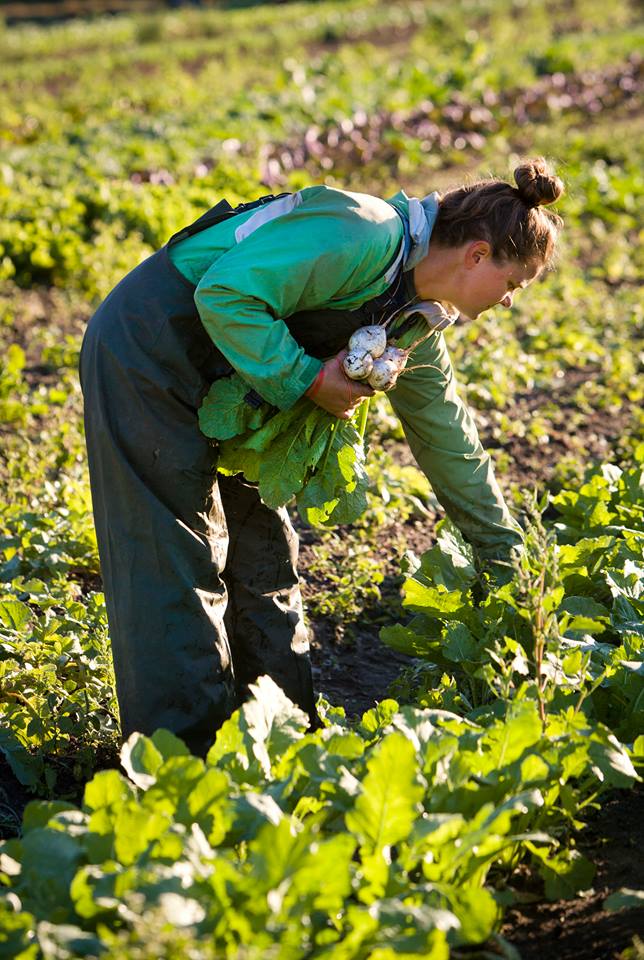As winter nears, the sun’s daily visits shorten to the point where it barely seems to have risen before it begins its descent. Crazy fluctuations in the temperature keep us from settling yet into winter mode, but surely we know that 60 degrees on a mid-November morning in Concord, Massachusetts is an anomaly, and soon we’ll be leaning into a bitter wind, faces stung with cold and blowing snow, trudging carefully over the frozen ground to avoid the treacherous ice patches hidden beneath a deceptive dusting. And, of course, there’ll be no really fresh vegetables or fruit.
Winter does have its charm: landscapes recently blanketed by a windless snow; the tang of wood smoke and its promise of warmth in the evening as the light leaches from the sky; sports that require the slippery surfaces that winter provides. Supermarket produce is not one of winter’s charms, though it is (usually) better than none at all—my hat’s off to those who can live off roots, pickles and such all winter, but not I. My general disappointment with the ‘fruits’ of winter—trucked in from Arizona, Florida and the like—just sharpens my anticipation for the moment when Concord begins again to bloom, when the sun climbs higher and stays longer, when the asparagus pokes up through the soil, the strawberries blush. Winter, despite its rather thin consolations, is long and difficult—the promise of spring carries us through.
We had a productive season at Hutchins this year, though there were some tense moments. Things seemed late to begin, and flooding in late May led to additional delays and a rushed execution of our usually deliberate routines. Pest and disease outbreaks that I have adequately chronicled in other messages wreaked havoc with certain crops, and, in general, the various pitfalls and problems that beset any vegetable and fruit farm seemed arrayed against us in an unusually intimidating way. And yet while we worried about whether we would harvest any potatoes at all, and whether late blight would cut a month off our ‘normal’ tomato season, and whether the heat in July would nip all our fall crops in the bud (so to speak), the produce rolled in. The late, lamented Patrick McGrath’s carefully tended asparagus led off the season, followed by a good crop of strawberries and a great crop of blueberries. As we struggled to produce early kale and cabbage (usually a cinch), we had fine, extended harvests of peas and spinach (usually a headache). July was particularly worrisome, as summer crops just trickled in, and the brutal heat shut down the early crops and threatened to destroy the tender seedlings that would grow into the late crops—but then July ended, and with it went the heat and the rain, and we settled in to a long stretch of perfect weather. Not hot, not cold, and, importantly, no rain.
People who don’t farm or garden tend to think that rain in all its forms is an unmitigated blessing for the grower. When I get tired of hauling around irrigation pipe or remembering to shut off the drip irrigation in the evening, I can almost agree. And yet, the weather this late summer and fall was a compelling example of why big growers in arid climates, where they calculate and deliver just enough irrigation water for their crops, consider a rainstorm to be a disaster. Water makes everything grow, including fungus and bacteria. So when we get a long stretch without rain and with low humidity, disease pressure is almost nonexistent. As long as I’m careful to irrigate in a timely fashion, and in such a way that the leaves don’t stay wet for long periods, the dry weather is more of a blessing than rain would be. I do reserve the right to whine a bit about the lack of rain (when there is a lack), and to rail (feebly) against the myopic meteorologists who blithely enthuse about the endless beautiful beach weather. But I shouldn’t be taken too seriously…unless it gets really dry.
So late summer provided a delayed bounty, and without the usual accompanying rots, mildews, molds, blights, blasts and spots. Although late blight showed up early (ironically), the tomatoes kept producing, maintaining their quality and fine flavor almost through mid-October. I don’t think I’ve seen cleaner broccoli or cauliflower than we had this fall, and, after the temperatures dropped in late July, the beans started coming in beautiful and abundant. And of course, the apples provided a crop like we see only when the planets are in perfect alignment—clean, delicious, and prolific. And our numbers all came up in the annual lottery of hiring a seasonal workforce: this year’s group were easygoing, enthusiastic field and farmstand workers whose commitment and demeanor made the stressful times easier, and the easier times fun. And of course, the real key to our success, this year or any year, the sine qua non of any farm like ours: dedicated, enthusiastic, well-informed, creative, flexible (‘cause we didn’t always have what you came for) customers. Thanks for visiting us in the lean times and the fat, thanks for your appreciation of our efforts, your patience, good humor and loyalty.
We continue to set out a dwindling selection of produce on the porch for self-service sales, but supplies are running short and the weather’s getting cold, so it may not continue much longer. Here’s to a good winter, and we’ll see you in the spring.
Brian Cramer
Farm Manager
Hutchins Farm

